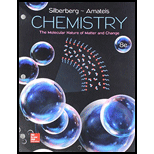
Concept explainers
(a)
Interpretation:
Whether from the number of moles of each type of atom in a given sample of the compound the molecular formula can be obtained or not is to be explained. Also, a road map is to be drawn if the molecular formula can be obtained.
Concept introduction:
The molecular formula describes the chemical symbols and numeric subscripts indicating the exact number of atoms comprising the whole chemical compound. The molecular formula does not suggest about the
The empirical formula describes the simplest whole-integer ratio of atoms of the chemical compound. The molecular formula can either be similar to empirical formula otherwise it can be the multiple of the empirical formula.
(b)
Interpretation:
Whether from the mass
Concept introduction:
The molecular formula describes the chemical symbols and numeric subscripts indicating the exact number of atoms comprising the whole chemical compound. The molecular formula does not suggest about the chemical bonding of that particular compound.
The empirical formula describes the simplest whole-integer ratio of atoms of the chemical compound. The molecular formula can either be similar to empirical formula otherwise it can be the multiple of the empirical formula.
The expression to calculate the mass of an element from the mass
The expression for the calculation of the number of moles is as follows:
(c)
Interpretation:
Whether from the mass
Concept introduction:
The molecular formula describes the chemical symbols and numeric subscripts indicating the exact number of atoms comprising the whole chemical compound. The molecular formula does not suggest about the chemical bonding of that particular compound.
The empirical formula describes the simplest whole-integer ratio of atoms of the chemical compound. The molecular formula can either be similar to empirical formula otherwise it can be the multiple of the empirical formula.
The expression to calculate the mass of an element from the mass
The expression for the calculation of the number of moles is as follows:
(d)
Interpretation:
Whether from the empirical formula and mass
Concept introduction:
The molecular formula describes the chemical symbols and numeric subscripts indicating the exact number of atoms comprising the whole chemical compound. The molecular formula does not suggest about the chemical bonding of that particular compound.
The empirical formula describes the simplest whole-integer ratio of atoms of the chemical compound. The molecular formula can either be similar to empirical formula otherwise it can be the multiple of the empirical formula.
(e)
Interpretation:
Whether from the structural formula the molecular formula can be obtained or not is to be explained. Also, a road map is to be drawn if the molecular formula can be obtained.
Concept introduction:
The molecular formula describes the chemical symbols and numeric subscripts indicating the exact number of atoms comprising the whole chemical compound. The molecular formula does not suggest about the chemical bonding of that particular compound.
The empirical formula describes the simplest whole-integer ratio of atoms of the chemical compound. The molecular formula can either be similar to empirical formula otherwise it can be the multiple of the empirical formula.
Want to see the full answer?
Check out a sample textbook solution
Chapter 3 Solutions
Loose Leaf for Chemistry: The Molecular Nature of Matter and Change
- Draw the mechanism to make the alcohol 2-hexanol. Draw the Mechanism to make the alcohol 1-hexanol.arrow_forwardDraw the mechanism for the formation of diol by starting with 1-pentanal in... basic conditions then acidic conditions then draw the mechanism for the formation of a carboxylic acid from your product.arrow_forwardIdentify each chiral carbon as either R or S. Identify the overall carbohydrates as L or Darrow_forward
- Ethers can be formed via acid-catalyzed acetal formation. Draw the mechanism for the molecule below and ethanol.arrow_forwardHOCH, H HO CH-OH OH H OH 11 CH₂OH F II OH H H 0 + H OHarrow_forwardDraw the mechanism for the formation of diol by starting with one pen and all in... basic conditions then acidic conditions then draw the mechanism for the formation of a carboxylic acid from your product.arrow_forward
 ChemistryChemistryISBN:9781305957404Author:Steven S. Zumdahl, Susan A. Zumdahl, Donald J. DeCostePublisher:Cengage Learning
ChemistryChemistryISBN:9781305957404Author:Steven S. Zumdahl, Susan A. Zumdahl, Donald J. DeCostePublisher:Cengage Learning ChemistryChemistryISBN:9781259911156Author:Raymond Chang Dr., Jason Overby ProfessorPublisher:McGraw-Hill Education
ChemistryChemistryISBN:9781259911156Author:Raymond Chang Dr., Jason Overby ProfessorPublisher:McGraw-Hill Education Principles of Instrumental AnalysisChemistryISBN:9781305577213Author:Douglas A. Skoog, F. James Holler, Stanley R. CrouchPublisher:Cengage Learning
Principles of Instrumental AnalysisChemistryISBN:9781305577213Author:Douglas A. Skoog, F. James Holler, Stanley R. CrouchPublisher:Cengage Learning Organic ChemistryChemistryISBN:9780078021558Author:Janice Gorzynski Smith Dr.Publisher:McGraw-Hill Education
Organic ChemistryChemistryISBN:9780078021558Author:Janice Gorzynski Smith Dr.Publisher:McGraw-Hill Education Chemistry: Principles and ReactionsChemistryISBN:9781305079373Author:William L. Masterton, Cecile N. HurleyPublisher:Cengage Learning
Chemistry: Principles and ReactionsChemistryISBN:9781305079373Author:William L. Masterton, Cecile N. HurleyPublisher:Cengage Learning Elementary Principles of Chemical Processes, Bind...ChemistryISBN:9781118431221Author:Richard M. Felder, Ronald W. Rousseau, Lisa G. BullardPublisher:WILEY
Elementary Principles of Chemical Processes, Bind...ChemistryISBN:9781118431221Author:Richard M. Felder, Ronald W. Rousseau, Lisa G. BullardPublisher:WILEY





